The hum of anticipation, like the gathering clouds, hung over the fifth stage of Mount Fuji, the preferred starting point for climbers to begin their ascent of Japan’s highest and best-known mountain.
They fueled up on noodles and curry, complete with a conical-shaped portion of rice, while those coming in the opposite direction bought mementoes of their time on the sacred peak — everything from branded whisky to Fuji-shaped cakes.
The only physical reminder that Fuji-san, an active volcano that last erupted in 1707, is also a place of worship was a Shinto shrine, its crimson torii gate almost touching the walls of a souvenir shop and restaurant.
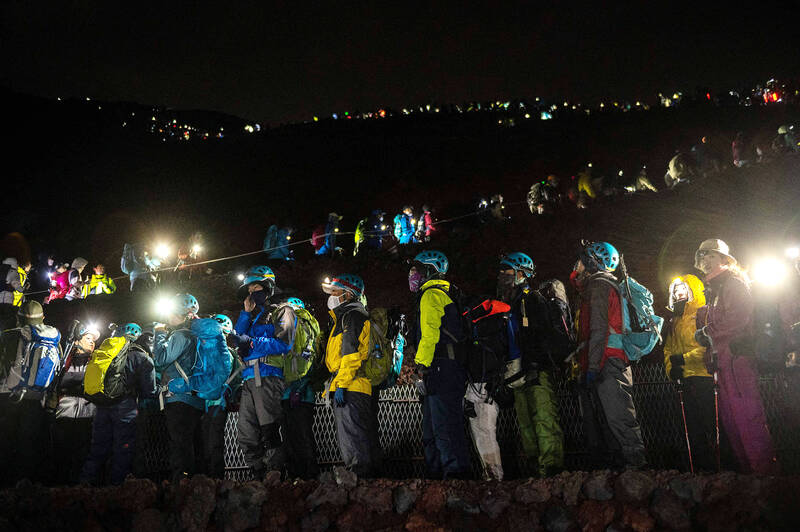
Photo: AFP
In 2013, when Unesco made the mountain a world heritage site, it described it as a historic place of pilgrimage that had inspired countless artists and poets.
While it still inspires awe, especially when viewed from a distance, Fuji is attracting huge numbers of visitors, who risk adding the mountain to a growing list of victims of tourism pollution, from
Amsterdam to Machu Picchu.
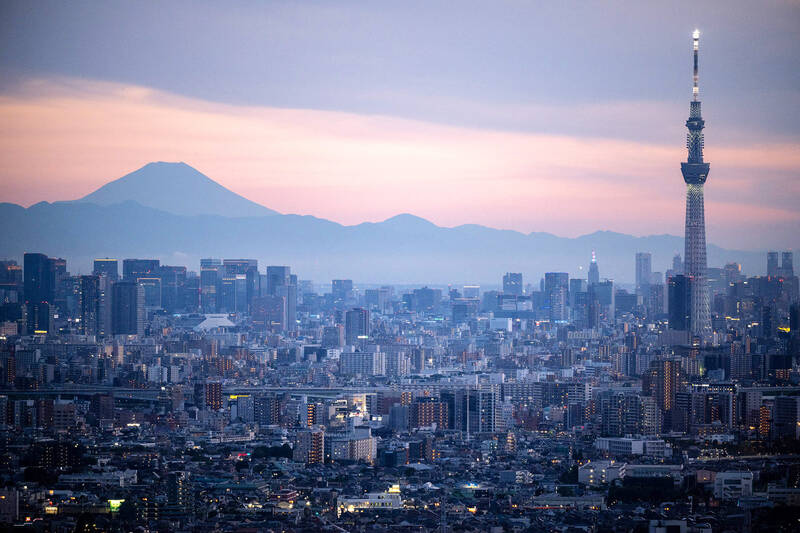
Photo: AFP
More than 2.3 million people visited the 2,400-meter-high fifth stage — with a smaller number continuing to the 10th and highest stage — in 2012, according to the local government in Yamanashi, one of two prefectures straddled by the mountain. By 2019, that number had more than doubled, to just over 5 million. In July, when the annual climbing season opens, about 65,000 hikers reached the summit, an increase of 17 percent from 2019.
Measures targeting polluting cars have reduced the number of private vehicles, but these have been replaced by an explosion in the number of buses, each depositing yet another large group of hikers. Overcrowding is placing unprecedented pressure on limited toilet facilities, creating mini mountains of litter and, say local guides, increasing the potential for accidents. Seasoned climbers find their route up the higher stages of the mountain blocked by large groups of inexperienced visitors, including those who, deceived by the gentle curve of its slopes on picture postcards, have underestimated the scale of the physical challenge that lies ahead.
“Over-tourism is the biggest problem,” said Masatake Izumi, a Yamanashi prefectural government official and expert on the history and culture of Mount Fuji.
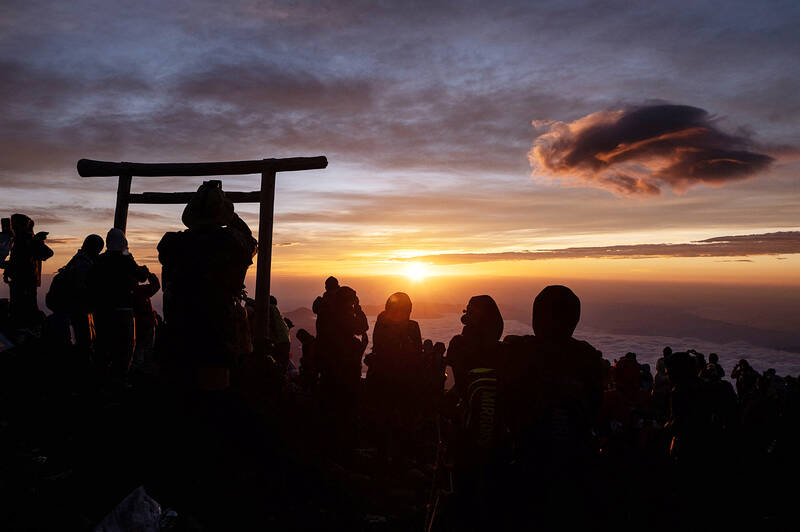
Photo: AFP
Izumi was skeptical of the potential economic benefits from encouraging more visitors.
“People on tour buses climb the mountain, buy an ice-cream on the way down and get straight back on the bus,” he said. “That’s it.”
On a recent morning, the trail leading to the sixth stage was busy with holidaying couples and occasional lone climbers. As the clouds descended and the temperature dropped, the trickle turned into a flood, as they were joined by parties of tourists from China and Taiwan, chatting as they planted their mountain sticks in the loose volcanic sand. Above, it was just possible to make out the heads of hikers as they zigzagged up another stage, taking them closer to the 3,667m summit.
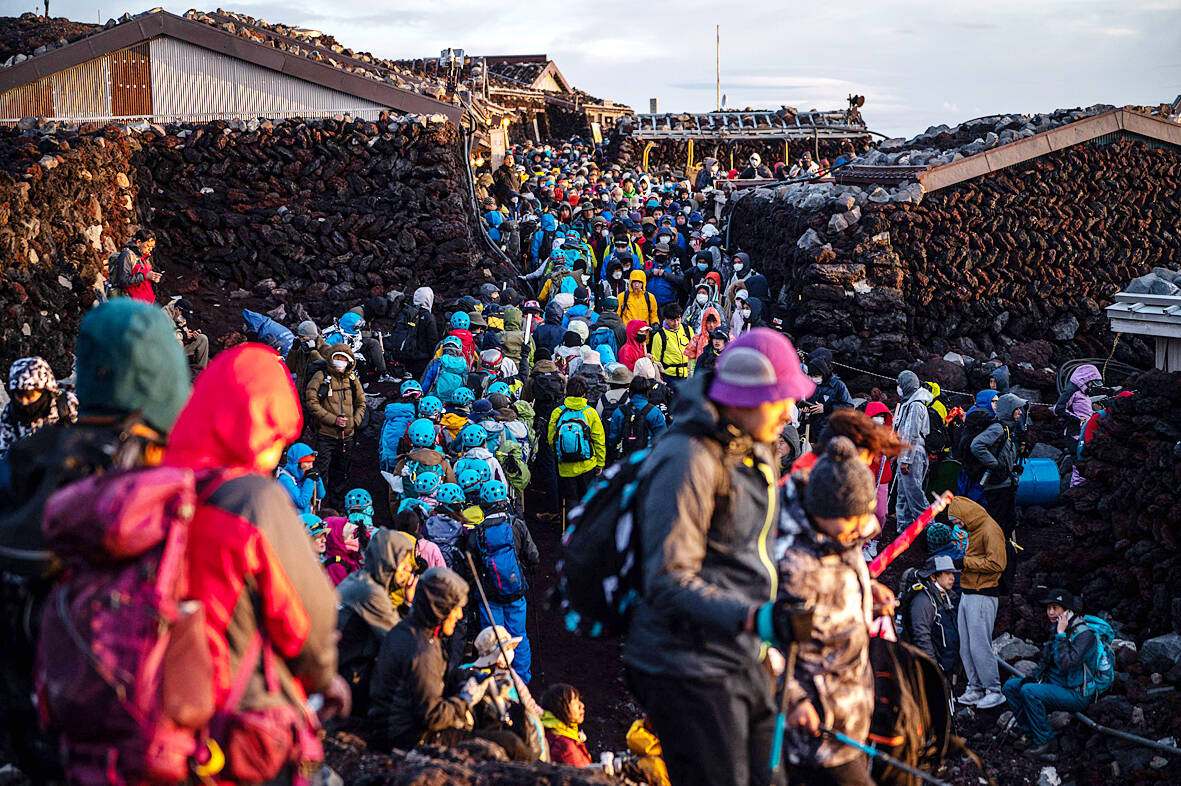
Photo: AFP
“It looks crowded today, but we get at least 10 times this number at weekends,” Izumi said.
Martijn van der Akker and Leanne Schuurman, a couple from the Netherlands, said climbing Mount Fuji had long been on their bucket list.
“We don’t get mountains like this at home,” said Schuurman.
They planned to continue to the seventh stage and rest overnight before reaching the summit to witness the sunrise.
“You come to places like this to experience nature, and if there are too many people, where is the beauty in that?” van der Akker said.
They said they would happily have bought tickets in advance if it meant being able to experience the mountain in relative solitude.
“If preserving the environment means having fewer people, then who are we to say no to an admission fee?” he added.
While officials have ruled out a blanket ban on hikers of the kind that has been in place on Uluru in Australia since 2019, the Yamanashi governor, Kotaro Nagasaki, has proposed the construction of a light railway — built on the current toll road — to control the number of people accessing the fifth stage.
“We need a shift from quantity to quality when it comes to tourism on Mount Fuji,” Nagasaki said this week.
Back at the fifth stage, a caretaker complained as she struggled with huge yellow bags of litter retrieved from the public toilets. “It’s incredible … I’ve filled 14 bags just today,” she said. “Something has to be done.”
Over-tourism has led to an increase in people needing first aid in an area miles from the nearest hospital.
“There are a lot more visitors, and that means we are getting busier,” said Shinsaku Hama, a registered nurse who triages injured or sick climbers at a medical center on the fifth stage.
Aside from twisted ankles, cuts and bruises, the center treats people who have not reckoned with the thinner air, who arrive suffering from chest pains, breathing problems and occasionally life-threatening conditions.
“We’ve had about five cases in which people needed to be taken to hospital already this season,” Hama said.
A growing problem is “bullet climbing” — a reference to underdressed, poorly equipped hikers who head straight to the summit without resting overnight in mountain huts — an approach that raises the risk of altitude sickness and hypothermia.
“Mount Fuji is not just any mountain,” Masayuki Oishi, from the Mt Fuji World Heritage Division, told the Mainichi Shimbun. “We want people to enjoy the climb, but they need to be properly prepared.”
Eniko Csapo, a Hungarian tourist, has dreamed of climbing Mount Fuji for years.
“I’m never surprised to find that places are crowded in Japan,” said Csapo, who has visited the country several times.
“This isn’t the place to come to make a solitary climb … everyone has the same dream,” added Csapo, who had brought a plastic bag for her rubbish. “You say Fuji and everyone knows what you mean. I know it’s going to be crowded on the way up. But it’s important to be respectful … some people don’t realize that this is a holy mountain.”

Nine Taiwanese nervously stand on an observation platform at Tokyo’s Haneda International Airport. It’s 9:20am on March 27, 1968, and they are awaiting the arrival of Liu Wen-ching (柳文卿), who is about to be deported back to Taiwan where he faces possible execution for his independence activities. As he is removed from a minibus, a tenth activist, Dai Tian-chao (戴天昭), jumps out of his hiding place and attacks the immigration officials — the nine other activists in tow — while urging Liu to make a run for it. But he’s pinned to the ground. Amid the commotion, Liu tries to
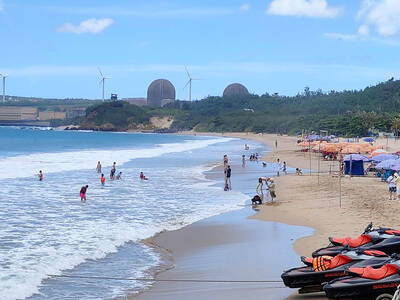
A dozen excited 10-year-olds are bouncing in their chairs. The small classroom’s walls are lined with racks of wetsuits and water equipment, and decorated with posters of turtles. But the students’ eyes are trained on their teacher, Tseng Ching-ming, describing the currents and sea conditions at nearby Banana Bay, where they’ll soon be going. “Today you have one mission: to take off your equipment and float in the water,” he says. Some of the kids grin, nervously. They don’t know it, but the students from Kenting-Eluan elementary school on Taiwan’s southernmost point, are rare among their peers and predecessors. Despite most of

A pig’s head sits atop a shelf, tufts of blonde hair sprouting from its taut scalp. Opposite, its chalky, wrinkled heart glows red in a bubbling vat of liquid, locks of thick dark hair and teeth scattered below. A giant screen shows the pig draped in a hospital gown. Is it dead? A surgeon inserts human teeth implants, then hair implants — beautifying the horrifyingly human-like animal. Chang Chen-shen (張辰申) calls Incarnation Project: Deviation Lovers “a satirical self-criticism, a critique on the fact that throughout our lives we’ve been instilled with ideas and things that don’t belong to us.” Chang

Feb. 10 to Feb. 16 More than three decades after penning the iconic High Green Mountains (高山青), a frail Teng Yu-ping (鄧禹平) finally visited the verdant peaks and blue streams of Alishan described in the lyrics. Often mistaken as an indigenous folk song, it was actually created in 1949 by Chinese filmmakers while shooting a scene for the movie Happenings in Alishan (阿里山風雲) in Taipei’s Beitou District (北投), recounts director Chang Ying (張英) in the 1999 book, Chang Ying’s Contributions to Taiwanese Cinema and Theater (打鑼三響包得行: 張英對台灣影劇的貢獻). The team was meant to return to China after filming, but